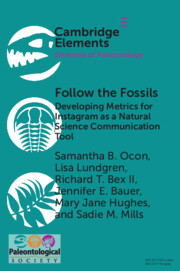References
Baker, S. A., and Walsh, M. J. (2018). “Good Morning Fitfam”: top posts, hashtags and gender display on Instagram. New Media & Society, 20(12), 1461444818777514. DOI: https://doi.org/10.1177/1461444818777514 Cardoso, M., Warrick, E., Golbeck, J., and Preece, J. (2016). Motivational impact of Facebook posts on environmental communities. Proceedings of the 19th ACM Conference on Computer Supported Cooperative Work and Social Computing Companion. New York: ACM, 237–40.
Catalani, J. (2014). Contributions by amateur paleontologists in 21st century paleontology. Palaeontol. Electron., 17(2), 3E. DOI: https://doi.org/10.26879/143 Clark, D. (2014). Engaging professionals and the public: outreach efforts of the Friends of the University of Michigan Museum of Paleontology. The Paleontological Society Special Publications, 13, 126–7. DOI: https://doi.org/10.1017/S2475262200012703 Creswell, J. (2011). Educational research: planning, conducting, and evaluating quantitative and qualitative research. 2nd ed. Boston, MA: Pearson.
Crippen, K. J., Ellis, S., Dunckel, B. A., Hendy, A. J. W., and MacFadden, B. J. (2016). Seeking shared practice: a juxtaposition of the attributes and activities of organized fossil groups with those of professional paleontology. J. Sci. Educ. Technol., 25(5), 731–46. DOI: https://doi.org/10.1007/s10956-016-9627-3 Falk, J. H., and Dierking, L. D. (2016). The museum experience revisited. New York: Taylor and Francis.
Gee, J. P. (2004). Affinity spaces, situated language and learning: a critique of traditional schooling. London: Routledge, 77–83.
Gee, J. P. (2005). Semiotic social spaces and affinity spaces: from the Age of Mythology to today’s schools. In Barton, D. & Tusting, K., eds., Beyond communities of practice: language power and social context. Cambridge: Cambridge University Press, 214–32. DOI: https://doi.org/10.1017/CBO9780511610554.012 Gee, J. P. (2017). Affinity spaces and 21st century learning. Educational Technology, 57(2), 27–31.
Gerber, B. L., Cavallo, A. M. L., and Marek, E. A. (2001). Relationships among informal learning environments, teaching procedures and scientific reasoning ability. Int. J. Sci. Educ., 23(5), 535–49. DOI: https://doi.org/10.1080/09500690116971 Greenhalgh, S. P., Rosenberg, J. M., Staudt Willet, K. B., Koehler, M. J., and Akcaoglu, M. (2020). Identifying multiple learning spaces within a single teacher-focused Twitter hashtag. Comput. Educ., 148, 103809. DOI: https://doi.org/10.1016/j.compedu.2020.103809 Lam, A., Bauer, J. E., Fraass, S. et al. (2019). Time Scavengers: an educational website to communicate climate change and evolutionary theory to the public through blogs, web pages, and social media platforms. JSTEM, 2(1), DOI: https://doi.org/10.15695/jstem/v2i1.05 Lave, J., and Wenger, E. (1991). Situated learning: legitimate peripheral participation. Cambridge: Cambridge University Press, 89–118.
Lundgren, L., and Crippen, K. J. (2017). Developing social paleontology: a case study implementing innovative social media applications. In D. Remenyl, ed., The Social Media in Practice Excellence Awards 2017 at ECSM 2017: an anthology of case histories, pp. 11–26. Reading, UK: Academic Conferences and Publishing International, Ltd.
Lundgren, L., Crippen, K. J., and Bex, R. T. (2018). Digging into the PIT: a new tool for characterizing the social paleontological community. Proceedings of E-Learn: World Conference on E-Learning in Corporate, Government, Healthcare, and Higher Education. Las Vegas, NV: Association for the Advancement of Computing in Education (AACE), 76–83.
Lundgren, L., Crippen, K. J., and Bex, R. T. (2020). Social media interaction as informal science learning: a comparison of message design in two niches. Res. Sci. Educ. DOI: https://doi.org/10.1007/s11165-019-09911-y MacFadden, B., Lundgren, L., Crippen, K., Dunckel, B., and Ellis, S. (2016). Amateur paleontological societies and fossil clubs, interactions with professional paleontologists, and social paleontology in the United States. Palaeontol. Electron., 19(2), 1E. DOI: https://doi.org/10.26879/161E Marsick, V. J., and Watkins, K. E. (2001) Informal and incidental learning. New Directions for Adult and Continuing Education, 2001(89), 25–34. DOI: https://doi.org/10.1002/ace.5 Morgan, E. M., Snelson, C., and Elison-Bowers, P. (2010). Image and video disclosure of substance use on social media websites. Comput. Human Behav., 26(6), 1405–11. DOI: https://doi.org/10.1016/j.chb.2010.04.017 Motulsky, H. (2018). GraphPad Prism. GraphPad Software.
Nobles, A. L., Leas, E. C., Noar, S. et al. (2020). Automated image analysis of Instagram posts: implications for risk perception and communication in public health using a case study of #HIV. PLoS ONE, 15(5), e0231155. DOI: https://doi.org/10.1371/journal.pone.0231155 Perez, V. J., Leder, R. M., Lundgren, L. et al. (2020). The Belgrade PaleoBlitz: a pilot project to engage amateur paleontologists. Palaeontologica Electronica, 23(1), A18. DOI: https://doi.org/10.26879/1013 Plotnick, R. E., Stigall, A. L., and Stefanescu, I. (2014). Evolution of paleontology: long-term gender trends in an earth-science discipline. GSAT, 24(11), 44–5. DOI: https://doi.org/10.1130/GSATG219GW.1 Staudt Willet, K. B. (2019). Revisiting how and why educators use Twitter: tweet types and purposes in #edchat. Journal of Research on Technology in Education, 51(3), 273–89. DOI: https://doi.org/10.1080/15391523.2019.1611507 Stoneburg, B., Perez, V., Lundgren, L., Ziegler, M., and Santos, G.-P. (2020). Cosplay for Science: leveraging pop culture to make science more accessible. Exhibition, 39(2).
Thelwall, M., and Vis, F. (2017). Gender and image sharing on Facebook, Twitter, Instagram, Snapchat and WhatsApp in the UK. Aslib Journal of Info. Mgmt., 69(6): 702–20.
Villaespesa, E., and Wowkowych, S. (2020). Ephemeral storytelling with social media: Snapchat and Instagram stories at the Brooklyn Museum. Social Media + Society, 6(1). DOI: https://doi.org/10.1177%2F2056305119898776 


